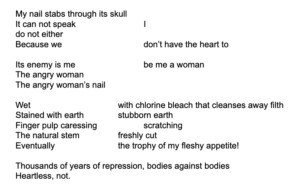Read 《展場裡見你》, Shiny Shuan-Yi Wu’s translation of ‘See You at the Exhibition’
In any museum visit, we tend to divide the exhibited artists into two major categories: friends, and other, gifted strangers we just don’t care about. I eventually navigated through various rooms and found our friends Leonardo, Botticelli, and Caravaggio, while imagining being one of the enthusiastic crowd with tears and awe in their eyes — or indifference, maybe? That was probably the most realistic part of my visit — I still felt no shame in going straight to whatever’s famous. What’s worse, it was nothing close to a pilgrimage.
What is an art pilgrimage anyway? A friend dropped me a link the other day which led to a long list of museums around the globe that can now be accessed through Google Streetview. I wasn’t consumed by greed. After careful consideration, I made this visit, to the Uffizi Gallery in Florence, my only destination for the day.
I was placed in a deeply extended hallway welcomed by gods and goddesses in their sculptures. They were beautifully pale just like their shadows on the wall behind them, but it seemed like they didn’t care to come alive. Each step triggered a moment of pixelation where the exquisitely painted ceilings, walls, tiles, and the elusive scenery outside the windows all melted into an opaque mass. But I was tenacious.
Travelling without moving used to be my dream. Legend says Caravaggio traveled to the twentieth century and stole photography, bringing back to Baroque. As he landed from the trip with his old brushes in hand, he found realism realer than real. We still haven’t figured out why he murdered. But we know he didn’t murder Medusa, Perseus did. Caravaggio only sealed the moment in a wooden shield, and it is still the most astonishing thing in the world. I carefully examined Medusa frozen at the moment of death floating in the vacuum of the display cabinet where her splashing blood is still cold. I tilted my head and knew that I should move on before she petrified me for staring into those eyes for too long.
I found Artemisia right across the display cabinet of Caravaggio’s Medusa. Another moment of violence: Artemisia planning for Judith to play it cool. Holofernes was almost gone. If you ever wonder why there have been no great women artists, there have always been, and they are friends too. Through Judith, Artemisia took her revenge. Since then, we no longer plan to stop debating if justice is a smokescreen for rage, or rage a smokescreen for justice.
I lingered and let my eye wander between Judith and the small exit of the exhibition room, not knowing where the exit led, although all it took was just one click to take me anywhere and another to take me back to yet another anywhere. I must have clicked a wrong spot on the screen that I found myself inside a wall where shadows of some strange windows (must be Italian windows) were projected. I lost sight of where I was, or rather, I never knew where I was this whole time. Who should I turn to for rescue?
It’s pretty ironic that, eventually, I found peace laying my eye on an empty chair between a fire extinguisher and an air conditioner at this temple of art. The place was haunted by deadly silence, the Muses were gone. I knew exactly why I lingered in front of scenes of murder, because a scream would make me feel so much more alive and I feel sorry that I can’t apologize enough. But in order to qualify the morality of a tourist, I didn’t leave until I took a ton of photos (or rather, screenshots).
A few days after my trip to Florence, my friend wants to meet in New York and I say of course. The link she sends takes me to the Met this time. I wait for her in an enormous exhibition hall standing next to a Greek column while before me, outside a wall of transparent glass, snowy trees stand frozen in the wind in the greatest city of the world (though I can’t really tell because I’ve still never been to New York, let alone all the other cities to compare, but that’s what people say). See you at the exhibition. But I begin to realize it’s most likely that I won’t see her. The scenery outside looks wintery, so does the exhibition hall.




